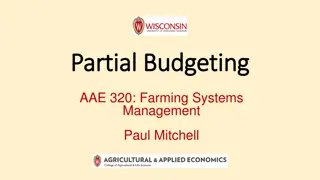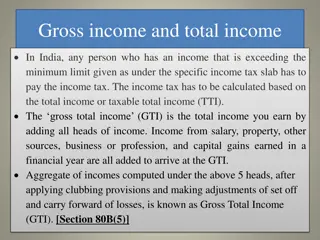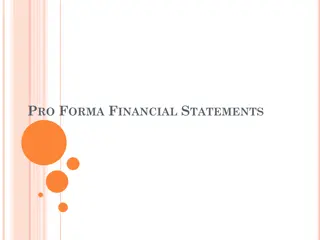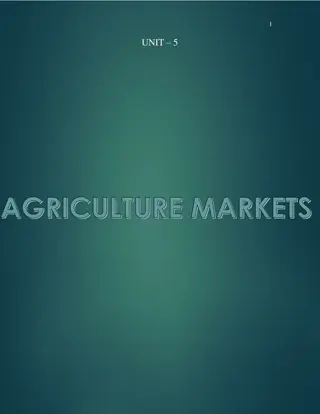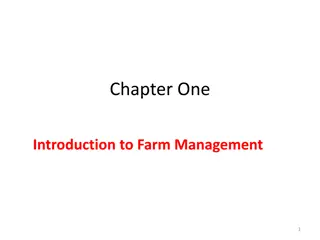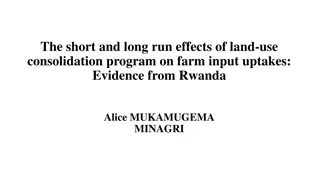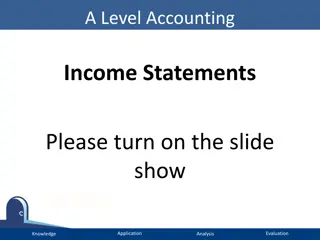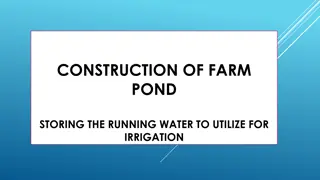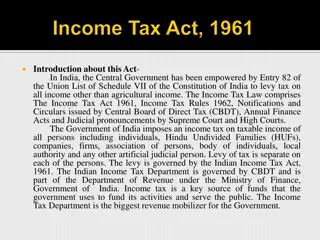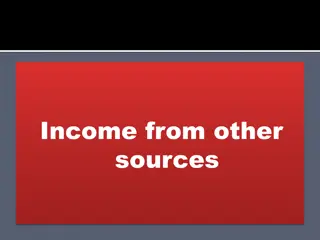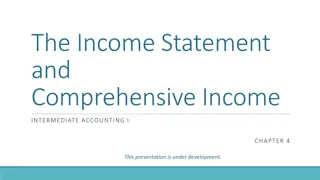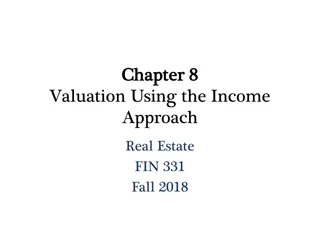Understanding Farm Income Statements in Agricultural Operations
Learn how to interpret accounting income statements in the context of agricultural activities. Discover key income measures and return rates, typical income trends in agriculture, and common accounting software used by Wisconsin farms.
Download Presentation

Please find below an Image/Link to download the presentation.
The content on the website is provided AS IS for your information and personal use only. It may not be sold, licensed, or shared on other websites without obtaining consent from the author. Download presentation by click this link. If you encounter any issues during the download, it is possible that the publisher has removed the file from their server.
E N D
Presentation Transcript
Farm Income Statement Analysis AAE 320 Paul D. Mitchell Agricultural & Applied Economics
Learning Goals How to read an accounting Income Statement as it pertains to agricultural operations How to calculate several key measures of income and rates of return Typical income and rates of return in agriculture Common accounting software packages used by Wisconsin farms
Income Statement Income Statement: Record of revenues and expenses over a period of time Remember: Balance Sheet is statement of assets, liabilities and equity at a point in time Other names for an income statement Operating Statement Profit and Loss Statement (P & L) Income = Revenue minus Costs Question it answers: How much money did I make last year?
Income Statement Income = Revenue minus Costs Account for all business revenue earned and costs during the period, both cash and non-cash Revenue consists of Cash Revenue and Non-Cash Revenue Costs consist of Cash Expenses and Non-Cash Expenses
Cash Revenue Crop sales Feeder livestock sales Crop and Livestock product sales Government program payments, including crop insurance and disaster payments Basically anything you sell! Will generally have a record for checks received
Non-Cash Revenue Will not always have records for these revenues Inventory Changes for commodities ready for sale Grain, feeder livestock Value of ending inventory minus value of beginning inventory Accounts Receivable: ending balance minus beginning balance Miscellaneous: Non-cash payments in kind, trades, custom harvest arrangements
Revenue: Special Agricultural Cases Gain/Loss from sale of culled breeding livestock or milk cows Treat as Cash Revenue, a normal part of production process Typically do not treat it as gain/loss from sale of a capital asset Change in value of raised breeding livestock or milk cows (a calf that becomes a heifer, a heifer that becomes a cow) Treat the increase in value of raised livestock as an increase in Non-Cash Revenue Practical way: Treat it like an inventory change for the herd Use a book value for each animal type, then calculate the ending value minus the beginning value for the herd
Revenue: Special Cases: Sale of Capital Assets Treat gains or losses on the Sale of Capital Assets as Cash Revenue Land: Selling Price minus Selling Costs Revenue changes only due to price changes Selling costs: often there are deferred taxes due Depreciable Assets: Selling Price minus Book Value (the value according to your depreciation schedule) Revenue changes due to price changes and errors in estimating depreciation This adjusts revenue for errors in depreciation, which are very common
Cash Expenses Purchased inputs: fertilizer, seed, fuel, chemicals, feeder livestock, feed, etc. Labor and services Repairs and maintenance Property taxes, insurance, etc. Everything you buy for the farm!!! Will generally have records for money spent
Non-Cash Expenses Will not always have records for these expenses Depreciation All capital assets (buildings, tractors, etc.) Breeding livestock, milk cows, perennial crops A cost of production to account for, even if you don t pay cash Accounts Payable Ending accounts payable balance minus beginning accounts payable balance
Prepaid Expenses Expenses paid in previous tax period for production during the current tax period Common examples: fertilizer, seed, feed, fuel etc. bought in previous tax year for this crop year Goal: to put expenses into the year they were used to produce crops/livestock Expenses for This Year = Prepaid Expense Last Year Prepaid Expense This Year Same thing for large feed, fuel and other infrequent purchases Main idea: put expenses into the year the inputs are used for
Accrued Expenses Cash interest paid Add accrued interest owed Subtract interest prepaid Property taxes paid Add accrued taxes owed Subtract taxes prepaid Income taxes owed Should estimate, but that very difficult Do Income Statement as pre-tax income Do after-tax Income Statement later after pay taxes
Income Statement Main Idea: Income = Revenue - Costs Revenue Expenses = Net Farm Income from Operations If subtract Unpaid Labor & Management and add Net Gains from Sale of Capital Assets get Net Farm Income Net Farm Income = Revenue Costs Unpaid Labor & Mgmt + Net Gains from Sale of Capital Assets Net Farm Income from Operations vs Net Farm Income: Trying to separate income from production activities versus income from managerial and investment activities This is the general idea, many variations due to differences in the non-cash costs and non-cash revenues included
Cash Accounting and Accrual Adjustments Most farms use cash accounting, especially for taxes Common problems cash accounting creates 1. Prepaid expenses: Buy inputs (seed, fertilizer, chemicals, feed, fuel) in one year, but use them the next year 2. Output sales in year different than production year: Harvest crops and livestock born/raised in one year, but sell in next year 3. Buy inputs and make sales to reduce taxable income Often cannot use costs and revenue from taxes to calculate profits by enterprise, only profits by year Accrual Adjustments: Put costs and revenues into the right year to determine profits by enterprise
Accrual Adjustment of Cash Income Statement Accrual accounting: the business standard: GAAP Accrual accounting: more accurate and useful for decision making: puts costs and revenue in the right years Cash accounting simple and has tax advantages Farms end up with two sets of accounting records if do it right : cash accounting for taxes and accrual accounting for decisions Farms create cash accounting records for tax purposes, then do an accrual adjusted cash basis income statement from them What was my income in 2021? Cash accounting for taxes What was my 2021 income from growing corn? Accrual adjusted Farm accountants work out the details
Simple Example to Illustrate Cash versus Accrual Accounting If 2020 is a high revenue year, to lower 2020 taxes, farmers often Increase prepaid expenses: Buy more than usual inputs in 2020 for the 2021 crop or herd use (feed, fertilizer, seed, fuel) Sell 2020 grain after Dec 31, 2020 so less 2020 income Just kicks the can down the road but eventually a low-income year happens and you can catch up To calculate profits from growing corn in 2020 Do not include revenue from corn grown in 2019 and sold in 2020, but do include revenue from corn sold in 2021 that was grown in 2020 Include costs paid in 2019 for inputs used in 2020, but not costs paid in 2020 for inputs used in 2021
Illustration of Accrual Adjustment What was my profit from growing corn in 2020? 2020 Crop Year Jan 1, 2020 Jan 1, 2021 Revenue on 2019 income statement Sell some of your 2019 crop Sell some of your 2020 crop Revenue on 2020 income statement Buy seed corn for 2021 crop Buy seed corn for 2020 crop Declare as income for 2020 taxes Declare as income for 2021 taxes Deduct as cost for 2019 taxes Deduct as cost for 2020 taxes Cost on 2021 income statement Cost on 2020 income statement
Uses for Income Statement See if business had a profit or a loss, but really want to know profitability Profitability: normalize for size to see if there is efficient use of resources to produce income Five Measures commonly used Net Farm Income from Operations Net Farm Income Rate of Return on Assets Rate of Return on Equity Operating Profit Ratio Should be Accrual Adjusted
Calculating Farm Income: Revenue You decide which non-cash sources to include and whether it is accrual adjusted or not Selling Things: self explanatory Capital Gains: Selling of capital (non-current) assets for prices different than their basis Sell land for different price than original cost Depreciable assets: selling for price different than remaining basis Are you going to do accrual adjustments?
Calculating Farm Income: Cost Operating Costs: You decide what non-cash costs to include and whether to use accrual adjustments Interest: separate it out as an operating expense Need to account for interest in some measures Unpaid Labor and Management: How much you pay yourself for labor and management: you decide Need to account for it in some measures Are you going to do accrual adjustments?
Net Farm Income from Operations (NFIfO) NFIfO = Revenue Operating Costs Interest NFIfO = Income made by the farm operation Does not include investment income from sale of capital asset sales: depreciation should already be included as a non-cash expense Does not include paying the operator/manager for time and labor
Net Farm Income (NFI) NFI = Revenue Operating Costs Interest Unpaid Labor & Management + Capital Gains Income generated by all farm business activities after paying all expenses (operation & investment activities) Includes net gain from sale of capital assets (investment activities) Includes paying for owner/operator s time and management (as though busines hired you as the manager) NFI = NFIfO Unpaid Labor & Management + Capital Gains
NFIfO vs NFI A farm is a mix of different activities: labor, management, investment, financing, etc. NFIfO: trying to get at the crop growing and livestock part of the operation, not investment or management NFI: tries to get at all the farm business earning (including investment activities) and after paying for the manager
Return on Assets (ROA) ROA = Revenue Operating Costs Unpaid Labor & Mgmt + Capital Gains ROA = NFI + Interest Income generated by all Farm Assets, including investment income Do not Subtract Interest Interest = cost of using someone else s money so your farm can have more assets than just what you can own with your equity ROA wants to calculate income generated by all assets, yours and other people s Other terms: Return to Capital
Return on Assets (ROA) Estimate cost of Unpaid Labor and Management What would it cost to hire someone to do all the currently unpaid labor and management? What would you/your family make at your next best alternatives (opportunity costs)? Removing Unpaid Labor and Management arbitrary, but important Whatever value you choose changes estimated ROA If ignore unpaid labor and management (which many do), will get higher ROA Know these issues before you compare with other businesses and with market returns
Rate of Return on Assets (ROROA) ROA compared to size of business How much income is the farm generating relative to the amount of assets used? ROROA = (ROA/Average Assets) x 100 Average Assets = average of assets over the time period of the Income Statement Go to Balance sheet and use average of total assets (current and non-current) at start and end of period Rates of return are why Balance Sheet and Income Statement go together
Rate of Return on Assets (ROROA) ROROA = (ROA/Average Assets) x 100 Average Assets = size of business during the accounting period Which basis for asset valuation: Cost or Market? Use Market Basis to compare farms and to compare to liquidating and getting market rates of return on financial investments Use Cost Basis to look at your trend over years Compare ROROA only if done in same way, especially asset valuation Do not include non-farm assets and income
Return on Equity (ROE) ROE = Revenue Operating Costs Interest Unpaid Labor and Management + Capital Gains ROE = ROA Interest ROE = NFI Of all the income generated by the Farm Assets, ROE is the part that goes to you as holder of equity in the business Return on your equity invested in the farm
Rate of Return on Equity (ROROE) ROROE = (ROE/Average Equity) x 100 Average Equity = average of equity at the beginning and end of the period Obtain from Balance Sheet Like ROROA, except use ROE, not ROA ROE removes Interest from ROA Interest is farm income to pay for debt equity Interest is the ROE for the bank, and the Interest Rate is roughly the bank s ROROE
ROROA, ROROE and Interest Rate Interest the only difference between ROE and ROA If Rate of Return on Assets > Interest Rate, Rate of Return on Equity > Rate of Return on Assets If Rate of Return on Assets < Interest Rate, Rate of Return on Equity < Rate of Return on Assets If ROROA > Interest Rate, then extra generated from use of external funds goes to increase ROROE
Operating Profit Margin Ratio (Profit Margin) Operating profit as percent of Revenue Operating Profit = Return on Assets Operating Profit Margin Ratio = ROA/Total Revenue Of all revenue generated by the business, how much does the business keep? Low Profit Margin: improve ratio first (by lowering costs) before expansion High Profit Margin: expansion may make sense
Summary of Farm Income Definitions Net Farm Income from Operations (NFIfO) = Revenue Operating Costs Interest Net Farm Income (NFI) = Revenue OperatingCosts Interest UnpaidLabrMngmt + CapGains NFI = NFIfO UnpaidLabrMngmt + CapGains Return on Assets (ROA) = Revenue OperatingCosts UnpaidLabrMngmt + CapGains ROA = NFIfO + Interest UnpaidLabrMngmt + CapGains ROA = NFI + Interest Return on Equity (ROE) = Revenue OperatingCosts Interest UnpaidLabrMngmt + CapGains ROE = ROA Interest = NFI Profit Margin = ROA/Total Revenue
Farm Income: Final Comment When a small business or farm does their accounting (or pays some one to do it) and they calculate farm income They decide how they want to deal with non-cash costs, non-cash revenues, depreciation, inventory changes, accrued expenses, prepaid expenses, accrual adjustments and unpaid labor and management costs for themselves and their family When comparing farms to one another, for an accurate comparison, must use the same assumptions for non-cash costs, non-cash revenues, depreciation, inventory changes, accrued expenses, prepaid expenses, accrual adjustments and unpaid labor and management
Summary How to develop an Income Statement Accrual Accounting vs Cash Accounting Accrual Adjusted Cash Accounting How to calculate and interpret measures from Income Statement Net Farm Income Net Farm Income from Operations Return on Assets and Rate of Return on Assets Return on Equity and Rate of Return on Equity Profit Margin Look at example rates and margins Look at example income statement
Rates of Return in Dairy UW Center for Dairy Profitability http://cdp.wisc.edu/pdf/02bench.pdf http://cdp.wisc.edu/Financial%20Benchmarks.htm Two methods Assets at Cost Basis with Tax Depreciation Assets at Market Basis with Economic Depreciation Does NOT include cost of unpaid labor and management or opportunity cost of owner equity
Average Profitability in WI Dairy Cost Basis and Tax Depreciation 2002 4.00% -1.69% 4.99% 2001 2000 7.91% 9.07% 10.25% ROROA ROROE Profit Margin 10.01% 16.15% 12.38% Market Value and Economic Depreciation 2002 2.17% 0.05% 5.79% 2001 5.65% 4.82% 13.31% 2000 4.24% 2.34% 10.52% ROROA ROROE Profit Margin
ROROA in WI Dairy: AgFA Farms 2002 Range of ROROA Range Year ROROA 1995 5.57% 1996 5.36% 1997 5.42% 1998 9.20% 1999 7.56% 2000 4.24% 2001 5.65% 2002 2.17% Year 2005 2006 2007 2008 2009 ROROA 6.77% 3.25% 8.39% 6.49% -1.65% % Farms < 0% 35.5% 0% - 2.5% 20.1% 2.5% - 5% 16.3% 5% - 7.5% 14.0% 7.5% - 10% 7.1% > 10% 7.1% * Assets at Market Value and Economic Depreciation
2009: A Bad Year for Dairy NFI ROROA ROROE Top 40% $77,098 3.32% 2.63% The Rest -$23,794 -7.84% -2.83% 473 Farms in AgFA database for 2009 Even in bad years, some farms make money
More Recent WI Dairy Data 250 famers for 2014-2016 Larger farms have higher ROA, but more leveraged, so they don t keep as much of the ROA as ROE Write-up does not explain asset valuation method, non- cash costs used and unpaid labor and management assumptions Profit Margin Debt to Asset Ratio 15.6% 25.5% 45.6% 59.1% 62.0% 62.2% Herd Size ROA <50 50-99 100-199 2.4% 8.7% 200-499 4.0% 10.6% 500-999 4.9% 12.4% >1,000 6.8% 13.3% All 2.2% 9.0% 0.5% 3.5% 1.6% 8.9% Source: https://cdp.wisc.edu/wp-content/uploads/Profitability-14_15_16-C-1.pdf
More Recent WI Dairy Data Distribution of ROA by Herd Size 250 famers for 2014-2016 Even in good years, some farms lose money Even in bad years, some farms make money Bottom 10% -3.8% -3.2% -2.5% -2.0% -0.9% 0.4% Bottom 25% -1.5% -0.6% 0.1% 1.2% 2.0% 2.4% Top 25% Top 10% Herd Size <50 50-99 100-199 200-499 500-999 >1,000 Median 0.5% 1.9% 4.6% 1.6% 4.2% 9.1% 2.4% 5.7% 9.6% 4.0% 8.1% 12.3% 4.9% 9.6% 14.1% 6.8% 9.0% 15.4% Source: https://cdp.wisc.edu/wp-content/uploads/Profitability-14_15_16-C-1.pdf
IA 1990-1998 by Type and 2000-2006 IA 1990-1998 ROROA ROROE Profit Margin Grain 7.3% 6.0% 22.3% Hog 7.4% 6.3% 20.9% Fed Beef Cow-Calf 6.0% 4.5% 4.6% 2.6% 23.1% 16.0% Dairy 7.6% 7.5% 21.1% IA 2000-2006 ROROA ROROE Profit Margin Current Ratio Debt to Asset Top 20% 12.8% 15.1% 22.9% 3.45 0.41 Upper 20-40% Middle 20% 11.4% 7.9% 12.7% 8.1% 20.1% 17.0% 3.44 2.50 0.37 0.37 Lower 20-40% 9.2% 11.5% 16.7% 1.87 0.36 Lowest 20% 4.4% 2.9% 9.0% 1.62 0.44 Source: http://www.extension.iastate.edu/Publications/FM1883.pdf
IL and MN 2004 IL 2004 Grain Hog Beef Dairy ROROA 6.2% 13.4% 2.9% 9.6% ROROE 7.1% 19.2% 2.6% 11.2% MN 2004 Average Top 20% Btm 20% ROROA 8.0% 13.4% -2.7% ROROE 10.9% 20.8% -18.0% Profit Margin 17.6% 26.0% -8.0%
Source: http://farmdocdaily.illinois.edu/2016/10/financial-performance-of-illinois-grain-farms.html
Farm Accounting Programs (from Jenny Vanderlin, UW CDP) AAIMS: Agricultural Accounting & Management Information System CDP developed and supports, cheap ($150) for dairy only AgManager by AgriSolutions General farm accounting, Farm Credit Services use Redwing sells CenterPoint and Perception More expensive, used by ag accounting firms CenterPoint is newer, more for farmers Others: Farm Fund$, PeachTree, QuickBooks, Quicken, MoneyWorks CDP & UWEX presentations & workshops for farmers to learn more Heart of the Farm, Annie s Project, plus as requested
WI Farm Management Associations Fox Valley Farm Management http://fvfma.com/ in Appleton, WI with about 700 members Lakeshore Farm Management http://www.lakeshorefarmmanagement.com/ in Valders, WI with about 1,000 members Services provided to members 1. Tax preparation, management and planning 2. Computerized and hand record-keeping systems 3. Scheduled "on the farm" consultations 4. Yearly farm business summary and analysis Ag Lenders, UW Extension and CDP
More Information UWEX Center for Dairy Profitability (CDP) FarmDOC IL Extension Center for Farm Financial Management MN Extension AgDecision Maker IA Extension Farm Financial Standards Council UW CDP soon to release FARMBENCH to replace Agriculture Financial Advisor (AgFA)
Learning Goals How to prepare and read an accounting Income Statement as it pertains to agricultural operations How and why to do accrual adjustments to income statement How to calculate key measures of income and rates of return NFIfO, NFI, ROA, ROROA, ROE, ROROE, Profit Margin Typical income and rates of return in agriculture Common accounting software used by WI farms




